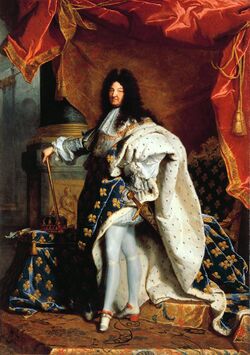History:The Age of Louis XIV
 Louis XIV of France | |
| Author | Voltaire |
|---|---|
| Original title | Le Siècle de Louis XIV |
| Country | France |
| Language | French |
| Subject | History of France |
| Genre | History, historiography |
Publication date | 1751 |
The Age of Louis XIV (Le Siècle de Louis XIV, also translated The Century of Louis XIV) is a historical work by the French historian, philosopher, and writer Voltaire, first published in 1751.[1] Through it, the French 17th century became identified with Louis XIV of France, who reigned from 1643 to 1715.[2]
Background
A letter in May 1732 is the first recorded mention of Voltaire's intent to write a history of the reign of Louis XIV.[3] He stopped and resumed the project multiple times, expressing the fear that he might not live long enough to complete it.[3] For preparation, he read two hundred volumes of material, plus many unpublished memoirs, as well as historical documents he found in the archives of the Louvre.[4]
Content
In common with other Enlightenment philosophers, Voltaire saw the age of Alexander the Great and Pericles, the age of Caesar and Augustus, and the Italian Renaissance as "great ages" or "ages of light". He presented the age of Louis XIV as the fourth and greatest.[5]
The period covered by the history corresponds neither to the 17th century nor the reign of Louis XIV, running from the last years of Cardinal Richelieu to the years after Louis XIV's death, in 36 chapters.[6] Voltaire described this as the age in which the arts and philosophy achieved their greatest perfection. By praising the excellence of a past age, he implicitly criticised the reign of Louis XV as an age of decline.[6]
Voltaire repeatedly remarked that he aimed less at a conventional history of great men and events, than something like a painting: he highlighted historical and cultural trends in the way that a painter brings out shadings of light and color which may be more important than the ostensible subject depicted. Rather than chronicling military victories, he saw more greatness in the progress of reason and culture, such as the advance of art or the rejection of medieval superstition and the end of imprisonment for sorcery.[3]
Reception
The Protestant writer Laurent Angliviel de la Beaumelle published an annotated version of the book, Notes sur le siècle de Louis XIV, in 1753, adding many attacks against Voltaire.[7]
In the early 19th century, the English writer Hannah More wrote that Voltaire had "decorated both the period and the king with so much that is great and brilliant, that they fill a large space in the eye of the reader."[8] The American writer Virginia Randolph Cary wrote in 1828 that "Voltaire's General History, and his Age of Lewis XIV, will always be read with pleasure."[9]
The publication of new editions of The Age of Louis XIV in the late 20th century helped to renew interest in Voltaire as a historian.[2] Modern scholars have described it as "the foundational text of French literary history" and "a milestone on the road to modern history-writing".[10]
Published editions
- The Age of Louis XIV, translated by Martyn Percy Pollack 1961 (London: J. M. Dent; New York: E. P. Dutton) ISBN:9780460007801
- Siècle de Louis XIV, critical edition edited by Diego Venturino and others, in The Complete Works of Voltaire (Oxford: The Voltaire Foundation)
- Introduction in Volume 11A (2019) ISBN:978-0-7294-1146-2
- Introduction, dossier, index général in Volume 11B (2019) ISBN:978-0-7294-1222-3
- Liste et catalogue des écrivains in Volume 12 (2017) ISBN:978-0-7294-1147-9
- Chapters 1–12 in Volume 13A (2015) ISBN:978-0-7294-0965-0
- Chapters 13–24 in Volume 13B (2015) ISBN:978-0-7294-1156-1
- Chapters 25–30 in Volume 13C (2016) ISBN:978-0-7294-1157-8
- Chapters 31–39 in Volume 13D (2016) ISBN:978-0-7294-1155-4
References
- ↑ Cronk, Nicholas (2009) (in en). The Cambridge Companion to Voltaire. Cambridge University Press. p. xii. ISBN 9780521849739. https://books.google.com/books?id=oeVY2xQUY1oC.
- ↑ 2.0 2.1 Cronk, Nicholas (2009). "Introduction" (in en). The Cambridge Companion to Voltaire. Cambridge University Press. pp. 1–3. ISBN 9780521849739. https://books.google.com/books?id=oeVY2xQUY1oC.
- ↑ 3.0 3.1 3.2 Wade, Ira O. (2015) (in en). Intellectual Development of Voltaire. Princeton University Press. pp. 348–351. ISBN 9781400877829. https://books.google.com/books?id=hTXWCgAAQBAJ&q=voltaire%20painting&pg=PA348.
- ↑ Durant, Will; Durant, Ariel (2011) (in en). The Age of Voltaire: The Story of Civilization. Simon and Schuster. ISBN 9781451647662. https://books.google.com/books?id=OXXlCgQR4V8C.
- ↑ Montoya, Alicia (2013) (in en). Medievalist Enlightenment: From Charles Perrault to Jean-Jacques Rousseau. DS Brewer. p. 47. ISBN 9781843843429. https://books.google.com/books?id=syb6-0eW-_sC&pg=PA47.
- ↑ 6.0 6.1 Delon, Michel (4 December 2013) (in en). Encyclopedia of the Enlightenment. Routledge. p. 1227. ISBN 9781135959982. https://books.google.com/books?id=QEpJAgAAQBAJ.
- ↑ Ferret, Olivier (2009). "Voltaire pamphlets and polemic". in Cronk, Nicholas (in en). The Cambridge Companion to Voltaire. Cambridge University Press. ISBN 9780521849739. https://books.google.com/books?id=oeVY2xQUY1oC.
- ↑ More, Hannah (1819) (in en). The Works of Hannah More: Hints towards forming the character of a princess. T. Cadell and W. Davies, in the Strand. p. 85. https://books.google.com/books?id=tA9EAQAAMAAJ.
- ↑ Cary, Virginia Randolph (1828) (in en). Letters on Female Character Addressed to a Young Lady on the Death of Her Mother. Richmond, VA: A. Works. p. 130. https://archive.org/details/lettersonfemale00carygoog.
- ↑ "Voltaire Foundation: Reviews of the new critical edition of Voltaire's Siècle de Louis XIV". http://www.voltaire.ox.ac.uk/www_vf/ocv/ocv_siecle3.ssi.
External links
- English translation by William F. Fleming (1901) at the Online Library of Liberty
- An explorer’s guide to the Siècle de Louis XIV, Voltaire Foundation, University of Oxford
 |

